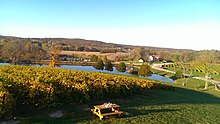Missouri Rhineland
This article needs additional citations for verification. (March 2013) |

The Missouri Rhineland is a geographical area of Missouri that extends from west of St. Louis to slightly east of Jefferson City, located mostly in the Missouri River Valley on both sides of the river. It is named for its similarities to the Rhineland region in central Europe, a wine growing area around the Rhine river and the German-Americans who determined that this part of Missouri would be good for grape growing. The soils of the Missouri River Valley and surrounding areas are mainly rocky residual soils, which are excellent for viticulture (growing of grapes/vineyards) though poor for most agricultural purposes. These soils were left after the carbonate (mainly limestone) bedrock weathered away to impurities of clayey soil and chert fragments. Farther to the north, glacial deposits and wind-deposited loess, a silty soil also associated with the glaciers, are intermingled with the residual soils.
While the soil could support other crops, the steep slopes of these areas were better used by vineyards. Settlements date to 1801. Dutzow, the first permanent German settlement in Missouri, was founded in 1832 by Baron von Bock. German settlers established the first wineries in the mid-19th century, and later Italian immigrants also entered the industry, especially near Rolla in Phelps County.
Vineyards succeeded so well that before Prohibition, Missouri was the second-largest wine-producing state in the nation. Prohibition ruined the industry and not until the 1960s did local winemakers start to rebuild it, part of a movement in states across the country.
An area around Augusta, Missouri was designated by the federal government as the first American Viticultural Area (AVA) in 1980, and one around Hermann, Missouri was designated an AVA in 1983. Much of the region of the Missouri Rhineland from Augusta to Jefferson City along the Missouri River is part of the larger Ozark Mountain AVA. Winning national tasting awards,[citation needed] the state's wine industry contributes to both the agricultural and tourist economies.
History
A German attorney and author named Gottfried Duden purchased land on the north side of the Missouri River along Lake Creek that he first visited in 1824. He was investigating the possibilities of settlement in the area by his countrymen. In 1827 he returned to Germany, which he felt was overpopulated. There in 1829 he published Bericht über eine Reise nach den westlichen Staaten Nordamerikas (Journal of a trip to the western states of North America), extolling the attractions of Missouri.
In 1832, members of the small so-called Berlin Society communally purchased land that became the village of Dutzow, founded by Baron von Bock of Mecklenberg, Germany in March 1834.
Led by Friedrich Muench and Paul Follenius of the Giessen Emigration Society, German immigrants arrived in the area in 1834. Resident Friedrich Muench became known for his expertise in the cultivation of grapes and wine making. Muench was a prominent writer and lecturer and wrote a number of books. He frequently wrote under the name of "Far West". His book American Grape Culture was published in 1859. Also, in 1859, Friedrich Muench's brother George founded Mount Pleasant Winery based upon the principles and advice of expert viticulturist, Friedrich Muench.
In 1836 the German Settlement Society began to look for a place to build a German community insulated from the increasing diversity of nationalities found in many American settlements. They chose to settle in Hermann, Missouri, and the first settlers arrived in 1837. An early leader of the settlers was George Bayer, who arrived in early 1838. The soil on the hillsides surrounding the settlement was not appropriate for many forms of agriculture, but was ideal for grapes. Hermann's trustees decided to sell tracts of land with the agreement that they be planted as vineyards.
The Weinstrasse
The area along Route 94 between Defiance and Marthasville has so many wineries that the highway has been nicknamed the Missouri Weinstrasse (wine route). It runs parallel to much of the Katy Trail, built in former railway right-of-way. This area has the highest concentration of wineries in the state. Many of these sit high up on south-facing bluffs above the river.
For a short while during the American Civil War, Missouri ranked as the number one producer of wine in the nation.[citation needed] Prior to Prohibition, Missouri was the United States' second largest producer of wine.[1] In 1920, Missouri had more than 100 wineries. Because of Prohibition all wineries were shut down, with one exception: Saint Stanislaus Seminary in Florissant was allowed to continue making sacramental wine.[1]
Prohibition lasted until 1933 and ended the Missouri wine industry. Vineyards were either pulled up and used for other purposes or left untended. Winery facilities were converted to serve other purposes or left to decay.
Some wineries began producing again after Prohibition ended, but significant production did not begin until the 1960s and 1970s. This was when small winemakers began building in many different areas of the United States. In 1965 Stone Hill Winery in Hermann, south of the Missouri River, was the first in the state to be re-established.
The Augusta AVA in Augusta was designated the first American Viticultural Area (AVA) in the United States in 1980 and Hermann AVA in Hermann was designated an AVA three years later. As of 2009,[needs update] 88 wineries were operating in Missouri.
See also
- Missouri wine
- Stone Hill Winery
- Les Bourgeois Winery
- Mount Pleasant Winery
- Giessen Emigration Society
- Alcohol laws of Missouri
- List of wineries in Missouri
- Isidor Bush
References
- ^ a b Brett Dufur, "History of Missouri Wine Industry", Missouri Wine Country, accessed October 19, 2009.
External links
- "Historic Hermann, MO, Heart of Missouri Wine Country", Hermann, Missouri Website
- "History of Washington", Washington Historical Society
- German American History Sources, Northwest Missouri State University Library
